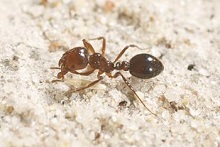 Australia’s agreed fire ant eradication program, joint-funded by all states, territories and the Commonwealth, is in jeopardy because only Queensland and new South Wales have met their funding commitments. As a result the containment and eradication work agreed under the plan has been cut by more than 50%.
Australia’s agreed fire ant eradication program, joint-funded by all states, territories and the Commonwealth, is in jeopardy because only Queensland and new South Wales have met their funding commitments. As a result the containment and eradication work agreed under the plan has been cut by more than 50%.
On this basis, the plan fails and the fire ant wins. Urgent action is required to reinstate the full program, or the consequences will be dire to sport and leisure, to a wide range of agricultural industries, plus tourism, to the survival of many native species, and to the simple enjoyment of back yards.
Australia was invaded by fire ants at some time in the 1990s, possibly as early as 1992. By the time they were discovered in 2001 they had spread to up to 71,000 hectares in the Port of Brisbane, and in the south-west suburbs between Brisbane and Ipswich. Ever since then there has been an effort to eliminate Solenopsis invicta, also known as the Red imported fire ant (RIFA).
An instructive American video has deemed RIFA the Most successful creature that has ever lived. According to the Invasive Species Council:
- ‘Fire ants are one of the world’s worst super pests and, if they are allowed to spread across the continent, their impact will be greater than cane toads, rabbits, feral cats and foxes combined.
Following a comprehensive strategic review of the joint-funded National Fire Ant Eradication Program, on July 13 this year the Commonwealth and State Agricultural Ministers Meeting agreed to contribute $592 million for new joint-funded response plan over 2023 – 2027 as the first phase towards complete eradication in 2032. In 2023/24 $133 million was needed. However, so far only Qld and NSW have honoured the commitment, as revealed in the Invasive Species Council’s media release Leaked government documents reveal fire ant funding failure that puts eradication plans at risk.
Unfortunately when Federal Agriculture Minister made the announcement he said that only $60 million was available in 2023-24 “while future funding arrangements are considered.” The current state of play is shown in this table compiled by the Invasive Species Council from the Plan documentation:
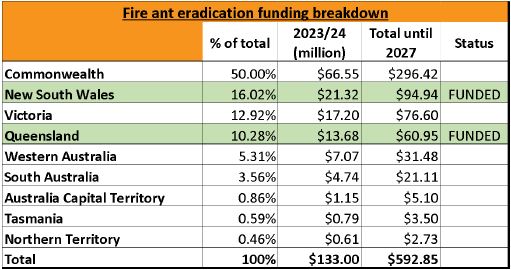
So, of the $134.094 million required for the first year, only $35.004 is available from Queensland and NSW, plus $24.994 from other sources, possibly from unspent funds brought forward from the earlier program.The Commonwealth contribution is just 0.0097% of budget outlays, struggling to rate as a rounding error.
The fire ant does not wait for budgets to be formulated at a convenient pedestrian pace.
This image shows the containment and eradication work as originally planned for 2023-24:
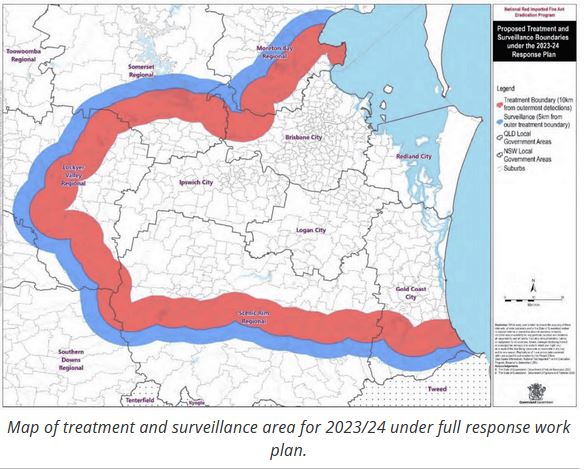
As the Queensland minister said on 25 July the New response plan has fire ants surrounded. If nothing had been done since 2001, natural spread alone would have seen the fire ant infesting “approximately 100 million hectares in an arc of country from Bowen in the north, west to Longreach and south to Canberra.”
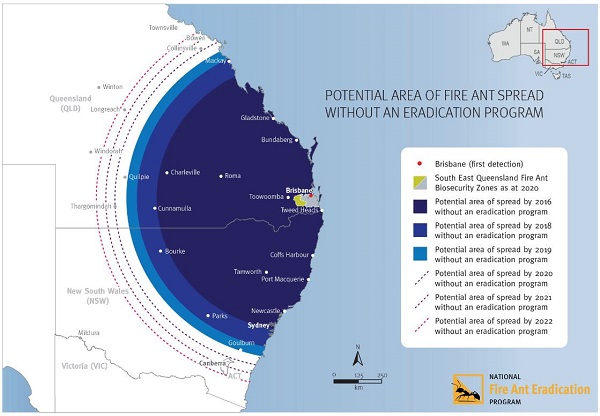
That would be on the way to infesting most of the country:
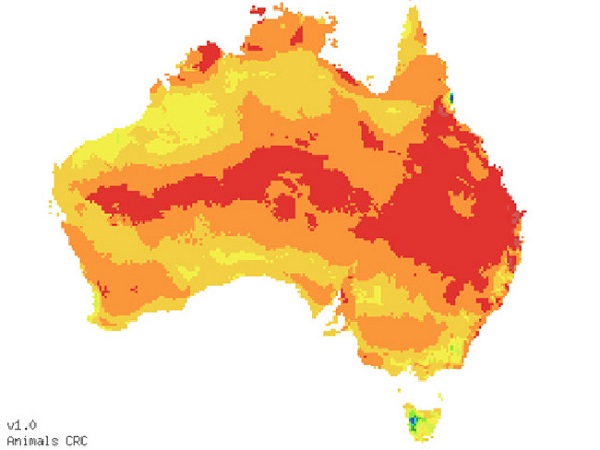
Unfortunately now work will only be undertaken along the southern edge of the infected area, less than half the work in the agreed plan:
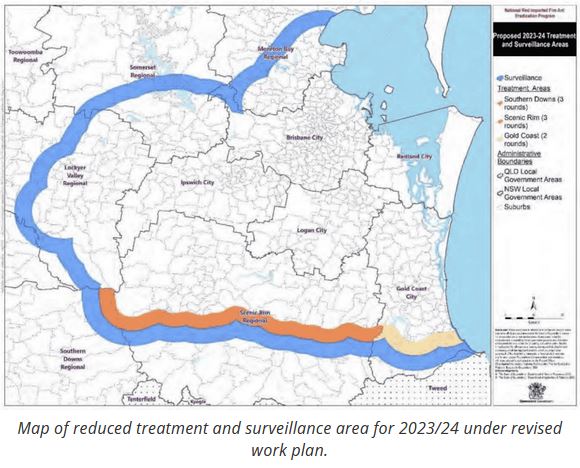
Already the ant has now broken out:
100 new fire ant nests have been detected on Minjerribah (North Stradbroke Island) and a dozen Morayfield, north of Brisbane – areas where eradication is not occurring in 2023/24 due to underfunding. New nests have also been found this week at Varsity Lakes on the southern Gold Coast.
That was 13 September, 2023.
Already the ant is just a queen’s flight away from the NSW border, and is not far from the headwaters of the Murray-Darling system. We should know that RIFA is a specialist at floating downstream in floods, forming a raft with the bodies of the workers that can float for months before finding a new home.
RIFA is an omnivore, consuming plants and animals. A nest may contain multiple queens and up to 400,000 workers. When disturbed the workers will attack in mass, and have been known to kill quite large animals, attacking the lips, eyes and other orifices. Humans can require medical attention or even die from anaphylactic shock. I understand the 95% of amphibians would be wiped out. It even kills ground bacteria and fungi.
Fire ants are attracted to electrical fields and tend to short out electrical components of infrastucture. They are capable of undermining driveways and roads, and can undermine or damage pipes and other infrastructure.
When a queen establishes a new nest she may only fly metres, resulting in extremely high densities of up to 2600 mounds per hectare, rendering parks or playing fields unusable.
Wikipedia has a useful section on the ant’s relationship to humans.
Wikipedia has a section on the ant’s relationship to humans.
According to the Wildlife Preservation Society of Queensland in Fire ants threaten wildlife and ecosystems in Australia:
- If left unchecked, fire ants will have severe ecological impacts because they reach extremely high densities. An assessment of their likely impact on 123 animals in southeast Queensland predicted population declines in about 45% of birds, 38% of mammals, 69% of reptiles and 95% of frogs. These reductions could result in possible extinctions.
In a budget the funds required in this case are pretty much a rounding error. Letting them run free to the west and north for a year is irrational and counterproductive.
Our problem now is that interrupted funding boosts RIFA’s onward march. Effectively those responsible in Victoria, South Australia, Western Australia, Tasmania and the Commonwealth are not simply kicking the can down the road. They have made a decision in favour of having the Red Imported Fire Ant as a permanent feature of Australia’s ecology.
Related links
National Fire Ant Eradication Program
Queensland Government Fire ants site
Commonwealth Government site Red imported fire ant (Solenopsis invicta)
SBS explainer – Fire ants spreading across Australia could have deadly consequences. Here’s why
While Australia has not yet reported a fire-ant-related death, the Invasive Species Council note there have been 85 reported deaths in the United States from anaphylactic shock.
- Symptoms of anaphylactic shock include skin reactions such as hives, constriction of the airways and difficulty breathing, low blood pressure and dizziness and fainting.
Anaphylactic shock can effect up to three per cent of the population.
This Invasive Species Council case study (2017) has value, as has a 2016 review article Red Imported Fire Ant in Australia: What if we lose the war?.
The American documentary Fire Ants – Most successful creature that has ever lived is highly recommended. It tells of how the the ant has invaded 13 states in the last 80 years. From 1957 to 1975 an eradication program was undertaken which massively reduced all manner of species including insects and birds, but the fire ant won and was the fastest to recover.
They report that the fire ant is now in at least 11 countries, including the Caribbean, New Zealand, Australia, Taiwan and China.
Apparently in Argentina five flies attack fire ants and nothing else. The ‘forward fly’ dive bombs them, injecting an egg inside the ant, which hatches and eats the ant from inside. Estimates suggest that this would reduce the population to 10 to 20% of what is now the case in the USA, which must have the authorities thinking, and may suggest a plan B for us if we have to live with the pest.

I would like everyone to tell everyone about this issue, especially decisionmakers in state and the federal government.
This and climate change too?
Bilb2, sadly you are correct.
On the fire ant I’ve been talking to the Invasive Species Council who have done a very neat Fire ants briefing note October 2023.
I’m looking to see if it works. I’m also trying to see whether anything can be done, which is of course secret business.
If we have success i will be much encouraged!
The link works, but I’m not sure it will work for everyone. Those who run the interwebs are making it a very strange place!
It seems the Australian Senate resolved to refer to the Rural and Regional Affairs and Transport References Committee for inquiry and report by 18 April 2024 on the following matters:
a) the expected costs and impacts, if red imported fire ants are able to spread across Australia, on human health, social amenity, agriculture, the environment, infrastructure and regional workers;
b) an assessment of the current and any proposed fire ant response plans for achieving the eradication of red imported fire ants;
c) an evaluation of funding provided for the current or any proposed fire ant response plans;
d) the effectiveness of eradication efforts and the spread of fire ants;
e) learnings of Varroa mite in managing red imported fire ants; and
f) any other related matters.
https://invasives.org.au/media-releases/federal-senate-to-shine-a-spotlight-on-fire-ant-funding-failures/
So far, it’s not yet mentioned on the Regional Affairs and Transport References Committee webpage.
Yes, Geoff, I’ve been talking to the Invasive Species Council about it. They had the reporting date brought forward to 18 April instead of July.
They have welcomed the referral, as your link shows, because it will publicise the issue. Seems few people are aware, those who are mostly don’t realise how serious it is, members of parliament and ministers are too relaxed about it all.
Reference Committee membership leaves much to be desired. Gerard Renwick is a nut case, don’t know the ALP members, Colbeck was useless in government, there is no-one from NSW.
The only media I’ve found is Senate to probe efforts to eradicate fire ants from AAP picked up by the West Australia.
LEAN at my instigation has taken it up as a national issue, and the Qld group are planning some serious lobbying. My worry is that the Senate referral will put off finding the funds. The inquiry is mostly investigating stuff we already know.
Yesterday the Commonwealth came good in providing full support to the four-year first phase of 10-year eradication plan – $268 million federal fire ant funding announcement welcomed.
Now it is up to Victoria and the rest.
Inquiry into Red Imported Fire Ants in Australia is now accepting submissions.